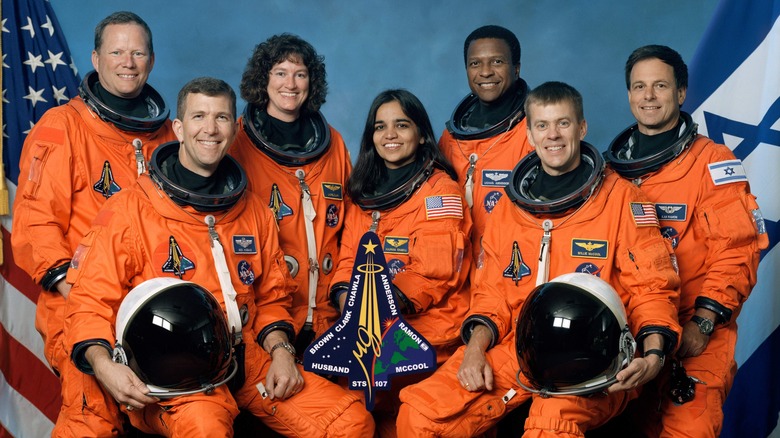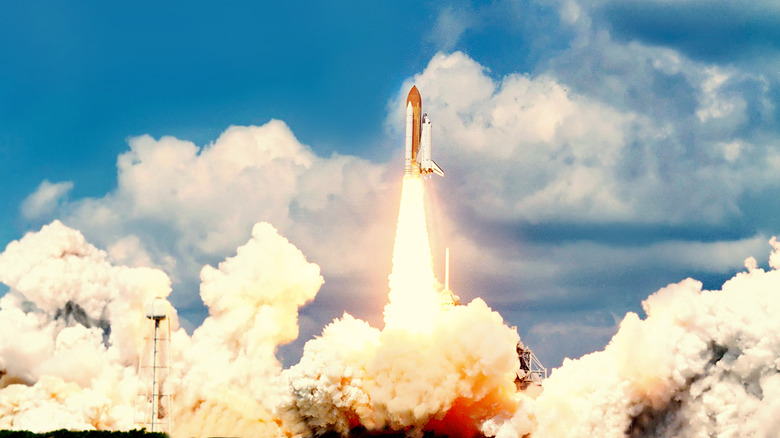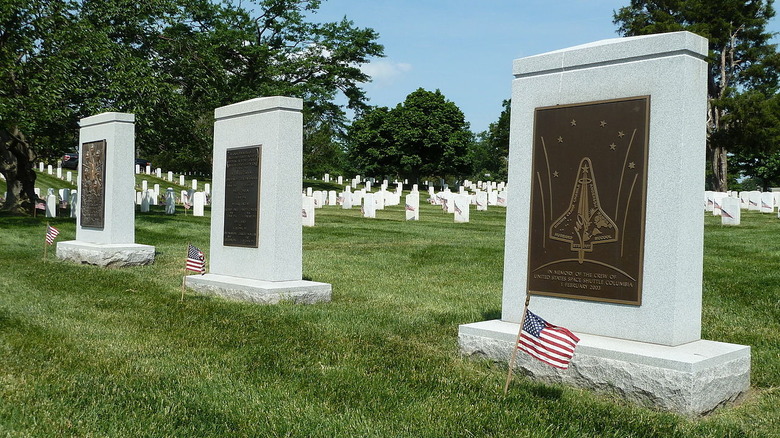What Happened To The Bodies Of The Columbia Crew?
Space flight isn't exactly the safest of activities. Back in 1967 — two years before humans first stepped on the moon — the three men of the Apollo 1 mission lost their lives in a fire during a launch pad training accident. Almost 20 years later in 1986 the Challenger space shuttle sent its seven-person crew hurtling into the Atlantic Ocean after it ignited in mid-air. Mechanical failure was to blame in both instances and led to changes in NASA safety procedures. Such changes, though, didn't preclude the possibility of further accidents. Case in point: the 2003 Columbia space shuttle disaster.
On February 1 of that year, the Columbia was reentering Earth's atmosphere after spending 16 days in space conducting research into microgravity. The time in orbit was a success, and the seven-person crew even had a little chat with the members of the International Space Station. That being said, there was some cause for concern. Eighty-two seconds into liftoff a piece of the Columbia's foam insulation broke off from the shuttle and struck its left wing. Mission control told the crew not to worry. Sixteen days later and sixteen minutes before the Columbia would have touched down in Texas, the shuttle exploded during reentry. All seven crew members died.
Five years later in 2008 NASA said that the crew likely survived the explosion but asphyxiated from a lack of oxygen or hitting something as their shuttle spun out of control and was torn apart. The crews' remains were eventually gathered and returned to their families. Three crew members are interred at Arlington National Cemetery.
Death by a confluence of factors
When the Columbia ignited in orbit in 2003, all seven of its crew members died during the remainder of their descent to Earth: David M. Brown, Rick D. Husband, Laurel B. Clark, Kalpana Chawla, Michael P. Anderson, William C. "Willie" McCool, and Ilan Ramon. The bit of foam that tore off the shuttle during liftoff had damaged the left wing just enough that the extreme temperatures experienced when reentering Earth's atmosphere tore the ship apart.
In 2008 NASA released a full, 400-page public report about the Columbia disaster. Amongst many other things, the document describes the horrific confluence of "five events with lethal potential" that killed the crew members: cabin depressurization; a "dynamic rotating load environment;" physically traumatic injuries; exposure to a near vacuum, aerodynamic acceleration, and cold atmospheric temperatures; and collision with the ground. Tragically and absurdly enough, the crew's gloves might have contributed to their deaths by making it more cumbersome to react to events.
As the U.S. Navy's Space Shuttle Columbia salvage report describes, a search team identified and recovered the remains of the crew in the first two weeks after the crash. To this end, members of the U.S. Forest Service and Texas Forest Service combed a 20-mile radius in southeastern Texas. Every time search parties discovered remains, an "Evidence Response Team" was summoned, consisting of members of the FBI, clergymen, local law enforcement, and other NASA astronauts. Local residents from Hemphill, Texas got involved in the search, as well. Ultimately, all seven crew members' remains were successfully recovered.
Memorialized at Arlington National Cemetery
As mentioned, the remains of three members of the Columbia crew — Michael P. Anderson, David M. Brown, and Laurel B. Clark — are interred at Arlington National Cemetery in individual graves. Those wishing to pay their respects can find these individuals in Section 46. The other crew members were interred according to their and their family's wishes. Kalpana Chawla, for instance, was cremated and had her ashes scattered in Zion National Park in Utah. Per Live Mint, her father said, "She always dreamt of the stars and somehow I feel she dissolved into the stars that day." Elsewhere, Ilan Ramon's remains were buried in Israel at a kibbutz near the Sea of Galilee, and Willie McCool's in Anacortes, Washington.
In 2003 President George W. Bush also signed the Columbia Memorial Act into law, which placed a memorial to the entire seven-person crew in Arlington the following year. Shortly after the accident he stated (per the George W. Bush Presidential Center), "The cause in which they died will continue. Mankind is led into the darkness beyond our world by the inspiration of discovery and the longing to understand."
Following the Columbia disaster the Columbia Accident Investigation Board told NASA that it needed to "ruthlessly seek and eliminate safety problems" plaguing its missions, as Space.com puts it. Such problems include anything from lax behavior amongst staff to replacing outdated materials like the foam that led to the Columbia's destruction. To this NASA replied, "The shuttle is now an aging system but still developmental in character." As of the time of writing, there has yet to be another shuttle catastrophe.
[Featured image by Rob Young via Wikimedia Commons | Cropped and scaled | CC BY 2.0 DEED]


